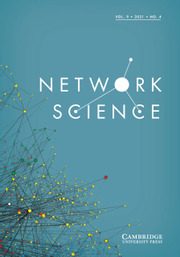Crossref Citations
This article has been cited by the following publications. This list is generated based on data provided by Crossref.
Cramer, Catherine
Sheetz, Lori
Sayama, Hiroki
Trunfio, Paul
Stanley, H. Eugene
and
Uzzo, Stephen
2015.
Complex Networks VI.
Vol. 597,
Issue. ,
p.
209.
Sheetz, Lori
Dunham, Veronica
and
Cooper, Judith
2015.
Professional development for network science as a multi-disciplinary curriculum tool.
p.
178.
Sayama, Hiroki
Cramer, Catherine
Porter, Mason A.
Sheetz, Lori
and
Uzzo, Stephen
2016.
What are essential concepts about networks?.
Journal of Complex Networks,
Vol. 4,
Issue. 3,
p.
457.
Patarakin, Evgeny D.
2017.
Digital Tools and Solutions for Inquiry-Based STEM Learning.
p.
112.
Cramer, Catherine
Gera, Ralucca
Labriole, Michaela
Sayama, Hiroki
Sheetz, Lori
Towlson, Emma
and
Uzzo, Stephen
2018.
Complex Networks IX.
p.
175.
Klimm, Florian
and
Maier, Benjamin F.
2020.
Commentary: A network science summer course for high-school students.
Network Science,
Vol. 8,
Issue. 4,
p.
596.
Cabrejas-Arce, Luis Miguel
Navarro, Jorge
Ahedo, Virginia
and
Galán, José Manuel
2021.
The 11th International Conference on EUropean Transnational Educational (ICEUTE 2020).
Vol. 1266,
Issue. ,
p.
205.
Stegehuis, Clara
2022.
Bringing network science to primary school.
Network Science,
Vol. 10,
Issue. 2,
p.
207.

